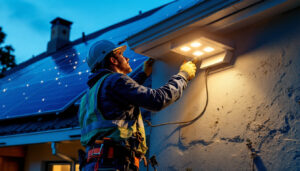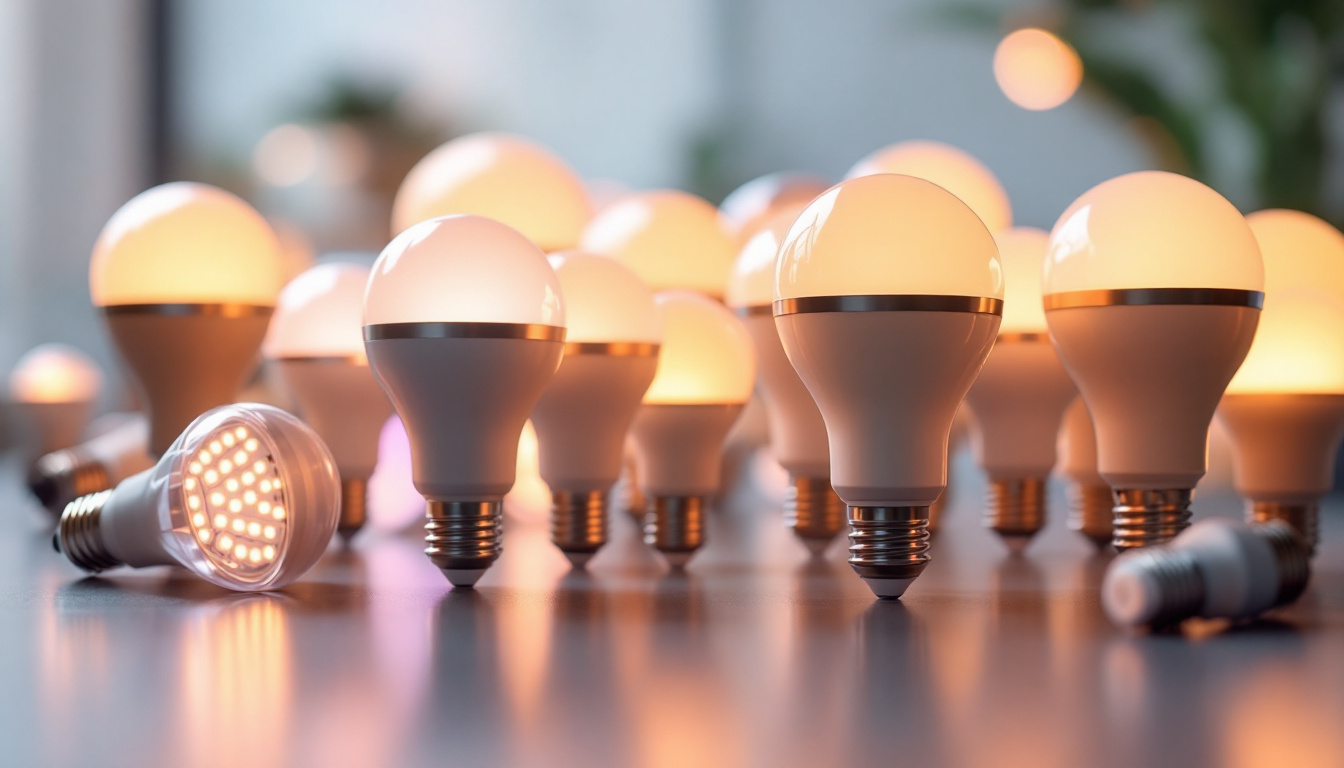

The lighting industry has witnessed significant advancements over the years, with innovations that not only enhance energy efficiency but also improve the overall quality of light. One crucial aspect of these advancements is the standardization of light bulb base types. Understanding the various base types and their implications is essential for lighting contractors who aim to provide optimal solutions for their clients.
Light bulb bases serve as the connection point between the bulb and the fixture. They play a pivotal role in ensuring that the bulb operates effectively and securely. The compatibility of a bulb with its fixture is determined by the base type, which can vary in size, shape, and design. This section will explore the most common types of light bulb bases and their characteristics.
Several standard light bulb base types are prevalent in the market, each designed for specific applications. Among the most recognized are the Edison screw bases, bayonet bases, and pin bases. The Edison screw base, for instance, is widely used in residential and commercial lighting due to its ease of installation and versatility.
In contrast, bayonet bases are often employed in automotive and specialized lighting applications, providing a secure fit that minimizes the risk of accidental disconnection. Pin bases, on the other hand, are commonly found in compact fluorescent lamps (CFLs) and LED bulbs, offering a compact design suited for tight spaces.
Ensuring compatibility between light bulbs and fixtures is vital for safety and performance. Using the wrong base type can lead to poor electrical contact, which may result in flickering lights or, in more severe cases, electrical hazards. For lighting contractors, understanding the nuances of base compatibility is crucial when advising clients on lighting solutions.
Moreover, as the industry shifts towards more energy-efficient options, the range of available base types has expanded. This evolution necessitates a thorough understanding of how different bases interact with various lighting technologies, including incandescent, LED, and fluorescent bulbs. For instance, while LED bulbs are often designed to fit existing fixtures with traditional bases, they may require specific drivers or transformers to function correctly, depending on the base type. This complexity highlights the importance of not only selecting the right bulb but also ensuring that the fixture can accommodate the energy-efficient technologies that are becoming increasingly popular.
Additionally, the rise of smart lighting solutions has introduced even more variations in base types. Smart bulbs often come with unique bases that allow them to connect to home automation systems, enabling features such as dimming, color changing, and remote control. As consumers become more interested in smart home technology, understanding the compatibility of these advanced bulbs with existing fixtures becomes essential. Therefore, staying informed about the latest developments in light bulb bases and their applications is crucial for both consumers and professionals in the lighting industry.
The lighting industry is continually evolving, and recent trends indicate a growing emphasis on standardization. As energy-efficient lighting becomes the norm, the demand for specific base types is increasing, leading to a shift in manufacturing practices and consumer preferences.
Standardization efforts are crucial in simplifying the selection process for contractors and consumers alike. Organizations and regulatory bodies are working to establish universal standards for light bulb bases, which can streamline the manufacturing process and reduce confusion in the marketplace. This trend not only benefits manufacturers by reducing production costs but also enhances the consumer experience by ensuring that products are compatible across different brands.
For lighting contractors, staying informed about these standardization efforts is essential. It allows them to recommend products confidently and ensures that their clients receive reliable and compatible lighting solutions. Additionally, as new technologies emerge, standardized base types can facilitate easier upgrades and replacements, minimizing downtime and disruption in both residential and commercial settings. The push for standardization also encourages innovation, as manufacturers are motivated to develop new products that meet these established criteria while still pushing the boundaries of design and functionality.
As energy efficiency becomes a top priority for both consumers and businesses, the demand for LED lighting has surged. LEDs often come with specific base types that differ from traditional incandescent bulbs. This shift necessitates that lighting contractors become well-versed in the various base types associated with LED technology.
Understanding the energy efficiency ratings and compatibility of LED bulbs with existing fixtures is vital for contractors aiming to provide sustainable solutions. This knowledge not only enhances the contractor’s reputation but also contributes to the overall goal of reducing energy consumption in the lighting sector. Furthermore, as smart lighting solutions gain popularity, contractors are increasingly required to navigate the complexities of integrating smart LED bulbs with advanced home automation systems. This includes understanding the unique base types that support smart functionalities, such as Wi-Fi or Bluetooth connectivity, which can further complicate the selection process but also offer exciting new opportunities for energy management and user customization.
While the standardization of light bulb bases presents numerous advantages, it is not without its challenges. The rapid pace of technological advancements and changing regulations can create confusion within the industry, particularly for contractors who must navigate these complexities.
The introduction of new lighting technologies, such as smart lighting and IoT-enabled fixtures, adds another layer of complexity to the standardization of light bulb bases. As these technologies evolve, the bases required for compatibility may also change, necessitating ongoing education and adaptation for lighting contractors.
Contractors must remain proactive in their approach, keeping abreast of the latest developments in lighting technology and base types. This commitment to continuous learning will enable them to provide informed recommendations and solutions to their clients. Additionally, the integration of smart lighting systems often requires a deeper understanding of network protocols and software applications, which can be daunting for those accustomed to traditional lighting setups. As a result, many contractors are investing in specialized training programs and certifications to enhance their expertise in these emerging technologies, ensuring they can meet the evolving demands of their clientele.
Regulatory compliance is another significant challenge facing the lighting industry. As governments implement stricter energy efficiency standards, lighting contractors must ensure that the products they recommend meet these regulations. This often involves understanding the specific base types associated with compliant products and their applications.
Failure to comply with regulations can lead to legal repercussions and damage a contractor’s reputation. Therefore, staying informed about regulatory changes and their implications for light bulb base types is essential for success in the industry. Moreover, the landscape of regulations can vary significantly from one region to another, adding another layer of complexity for contractors who work across multiple jurisdictions. This necessitates a thorough understanding of local codes and standards, which can be time-consuming and requires diligent research. To mitigate these challenges, many contractors are forming alliances with industry associations and regulatory bodies, allowing them to stay updated on best practices and compliance requirements while also fostering a network of support within the industry.
Looking ahead, the future of light bulb bases appears promising, with ongoing advancements in technology and design. As the industry continues to prioritize energy efficiency and sustainability, the development of new base types will likely follow suit, further enhancing compatibility and performance.
Innovations in base design are expected to focus on improving user experience and enhancing energy efficiency. For instance, advancements may lead to the creation of more compact and versatile bases that accommodate a wider range of bulbs and fixtures. This flexibility could simplify installations and reduce the need for multiple base types in a single project.
Furthermore, as smart lighting solutions gain traction, base designs may evolve to support integrated technologies that allow for seamless communication between fixtures and control systems. This evolution will require contractors to stay informed about emerging designs and their implications for installation and compatibility. The integration of wireless technology into base designs could also allow for remote operation and monitoring, enabling users to control their lighting environments from their smartphones or smart home systems. This added convenience not only enhances user experience but also contributes to energy savings by allowing for more precise control over lighting usage.
As consumers become more aware of the importance of energy efficiency and sustainability, their demand for information regarding light bulb bases will increase. Lighting contractors will play a vital role in educating clients about the various base types, their benefits, and how they impact overall lighting performance.
By providing clear and concise information, contractors can empower consumers to make informed decisions about their lighting choices, ultimately leading to greater satisfaction and long-term relationships. Additionally, workshops and informational sessions could be organized to demonstrate the advantages of newer base technologies, highlighting how they can lead to both cost savings and enhanced lighting quality. As consumers become more engaged, they are likely to seek out products that not only meet their aesthetic preferences but also align with their values concerning environmental responsibility, further driving the demand for innovative base designs that reflect these priorities.
The significance of standard light bulb base types in the lighting industry cannot be overstated. As the industry continues to evolve, understanding the various base types, their compatibility, and their implications for energy efficiency will be crucial for lighting contractors. By staying informed and adapting to new technologies and trends, contractors can provide optimal solutions that meet the needs of their clients while contributing to a more sustainable future.
As the demand for energy-efficient lighting solutions grows, so too does the importance of standardization in light bulb bases. Lighting contractors who embrace this knowledge will not only enhance their expertise but also position themselves as trusted advisors in an ever-changing industry.
Ready to enhance your lighting solutions with the latest standard light bulb base types? Look no further than LumenWholesale for a seamless transition to energy-efficient, high-quality lighting. Our extensive selection of spec-grade lighting products is designed to meet the highest industry standards, providing you with reliable and high-performance options for every project. Take advantage of our unbeatable wholesale prices, free shipping, and the convenience of cutting out the middleman. Elevate your lighting game and ensure your clients enjoy the best value by choosing Wholesale Lighting at the Best Value with LumenWholesale.

Discover how suspended ceiling lights can transform your space with innovative lighting designs.

Discover expert tips from a seasoned lighting contractor on how to select and install outdoor solar lights without common pitfalls.

Explore the evolution of lighting technology as we delve into the innovations that succeeded Edison’s incandescent bulb.

Discover the rising significance of MR16 LED globes in the lighting industry.
Get notified when NEW deals are released.
Optimize your budget with wholesale discounts.
Only top-quality, specification-grade lighting products.
No additional costs at checkout - what you see is what you pay.
We understand the unique needs of contractors.